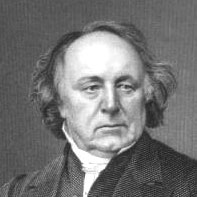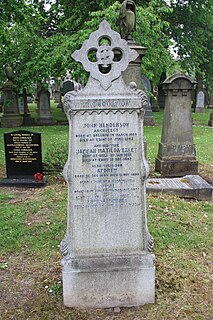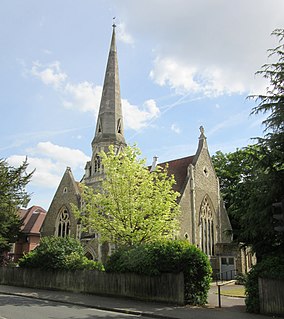
William Butterfield was a Gothic Revival architect and associated with the Oxford Movement. He is noted for his use of polychromy.

Sir George Gilbert Scott, known as Sir Gilbert Scott, was a prolific English Gothic Revival architect, chiefly associated with the design, building and renovation of churches and cathedrals, although he started his career as a leading designer of workhouses. Over 800 buildings were designed or altered by him.

Kensal Green Cemetery is a cemetery in the Kensal Green area of North Kensington in the Royal Borough of Kensington and Chelsea in London, England. Inspired by Père Lachaise Cemetery in Paris, it was founded by the barrister George Frederick Carden. The cemetery opened in 1833 and comprises 72 acres (29 ha) of grounds, including two conservation areas, adjoining a canal. The cemetery is home to at least 33 species of bird and other wildlife. This distinctive cemetery has memorials ranging from large mausoleums housing the rich and famous to many distinctive smaller graves and includes special areas dedicated to the very young. It has three chapels and serves all faiths. It is one of the Magnificent Seven cemeteries in London.

The Territory of Minnesota was an organized incorporated territory of the United States that existed from March 3, 1849, until May 11, 1858, when the eastern portion of the territory was admitted to the Union as the State of Minnesota.

Bellefontaine Cemetery is a nonprofit, non-denominational cemetery and arboretum in St. Louis, Missouri. Founded in 1849 as a rural cemetery, Bellefontaine is home to a number of architecturally significant monuments and mausoleums such as the Louis Sullivan-designed Wainwright Tomb, which is listed on the National Register of Historic Places. The cemetery contains 314 acres (1.27 km2) of land and over 87,000 graves, including those of William Clark, Adolphus Busch, Thomas Hart Benton, Rush Limbaugh, and William S. Burroughs. Many Union and Confederate soldiers from the American Civil War are buried at Bellefontaine, as well as numerous local and state politicians.

Richard Upjohn was a British-born American architect who emigrated to the United States and became most famous for his Gothic Revival churches. He was partially responsible for launching the movement to such popularity in the United States. Upjohn also did extensive work in and helped to popularize the Italianate style. He was a founder and the first president of the American Institute of Architects. His son, Richard Michell Upjohn, (1828-1903), was also a well-known architect and served as a partner in his continued architectural firm in New York.

Edward Bradley was an English clergyman and novelist. He was born in Kidderminster and educated at Durham University from which he took his pen name Cuthbert Bede, B.A. His most popular book was The Adventures of Mr. Verdant Green, on the experiences of an Oxford undergraduate. There was a sequel, Little Mr Bouncer and his friend Verdant Green. Tales of College Life, introduces the character of Mr Affable Canary. The celebrated illustrations to the Verdant Green books were the work of the author.

Thomas Binney (1798–1874) was an English Congregationalist divine of the 19th century, popularly known as the "Archbishop of Nonconformity". He was noted for sermons and writings in defence of the principles of Nonconformity, for devotional verse, and for involvement in the cause of anti-slavery.

John Pye-Smith was a Congregational minister, theologian and tutor, associated with reconciling geological sciences with the Bible, repealing the Corn Laws and abolishing slavery. He was the author of many learned works.
Henry Isaac Stevens FRIBA was an architect based in Derby. He was born in London, in 1806, and died in 1873. In the late 1850s he changed his name to Isaac Henry Stevens.

The City of London Cemetery and Crematorium is a cemetery and crematorium in the east of London. It is owned and operated by the City of London Corporation. It is designated Grade I on the Historic England National Register of Historic Parks and Gardens.
Jackson and Walford, later Jackson, Walford, and Hodder from 1861 was a London publishing firm and predecessor firm of Hodder & Stoughton. at 18 St Paul's Churchyard and 27 Paternoster Row in 1871 The publishers with their successive name changes were one of many London publishers that operated around St. Paul's Churchyard and Paternoster Row. They published the Congregational Year Books, which were the publications of the "Congregational Union of England and Wales, and the Confederated Societies." Matthew Hodder apprenticed there from the age of fourteen and became a partner in 1861. Upon the retirement of Messrs. Jackson and Walford in 1868, Thomas Wilberforce Stoughton joined Hodder and the firm was renamed Hodder & Stoughton. The firm then published both religious and secular works and has survived into the present day as an imprint of Hodder Headline.

John Tarring FRIBA (1806–1875) was an English Victorian ecclesiastical architect active in the mid-nineteenth century. Based in London, he designed many Gothic Revival churches for Nonconformist clients.

John Henderson was a Scottish architect operational in the mid-19th century. He is chiefly remembered as a church architect, with his early work being in the Gothic revival and tractarian style, before developing his own distinct style.
William Hendry Stowell (1800–1858) was a Manx nonconformist minister, college head, writer and periodical editor.
Samuel Groves was a British organ builder based in London.

James Matthews was a prominent 19th-century architect in northern Scotland who also served as Lord Provost of Aberdeen from 1883 to 1886 during which time he enacted an important city improvement plan. His work as an architect is largely in the Scots baronial style.

James Julius Wood (1800–1877) was a 19th-century Scottish minister who served as Moderator of the General Assembly of the Free Church of Scotland 1857/8.
The New-York Directory, published in 1786, was the first extant directory for New York City and the third published in the United States. It listed 846 names. A year earlier, the first two in the country were published in Philadelphia – the first, compiled by Francis White, was initially printed October 27, 1785, and the second, compiled by John Macpherson (1726–1792), was initially printed November 22, 1785.

Weybridge United Reformed Church is the United Reformed church serving the town of Weybridge in the English county of Surrey. The Decorated Gothic Revival church, a cruciform building with a tall spire, was designed in 1864 by John Tarring and opened the following year. Congregational services had commenced in the town in 1860 at the initiative of resident Benjamin Scott; the rapidly rising number of worshippers outgrew the rooms in which meetings were held, and Scott himself bought the land on which the church now stands and helped to finance its construction. The church joined the United Reformed Church denomination upon its formation in 1972. Historic England has listed the building at Grade II for its architectural and historical importance.















